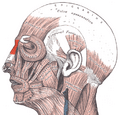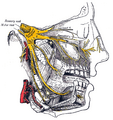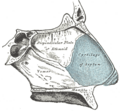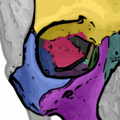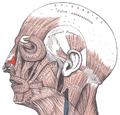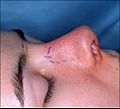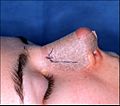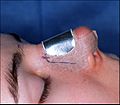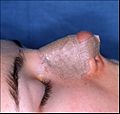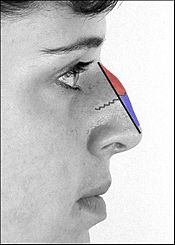
Rhinoplastic correction: A nasal-hump excision plan; the black line delineates the dorsal plane of the new nose.
Rhinoplasty (ῥίς rhis, nose + πλάσσειν plassein, to shape), commonly known as a nose job, is a plastic surgery procedure for correcting and reconstructing the nose. There are two types of plastic surgery used – reconstructive surgery that restores the form and functions of the nose and cosmetic surgery that improves the appearance of the nose. Reconstructive surgery seeks to resolve nasal injuries caused by various traumas including blunt, and penetrating trauma and trauma caused by blast injury. Reconstructive surgery also treats birth defects, breathing problems, and failed primary rhinoplasties. Most patients ask to remove a bump, narrow nostril width, change the angle between the nose and the mouth, as well as correct injuries, birth defects, or other problems that affect breathing, such as deviated nasal septum or a sinus condition.
Images for kids
-
-
Artificial nose, made of plated metal, 17th–18th century Europe. This would have been worn as an alternative to rhinoplasty.
-
Nasal anatomy: Squamous epithelium is one of several types of epithelia.
-
Nasal anatomy: The procerus muscle (musculus procerus, pyramidalis nasi, depressor glabellae).
-
Rhinoplasty: the surgical nose as aesthetic nasal segments.
-
Rhinoplasty: The Common carotid artery.
-
Nasal innervation: Cranial nerve V, the trigeminal nerve (nervus trigeminis) gives sensation to the nose, the face, and the upper jaw (maxilla).
-
Nasal anatomy: The shell-form turbinates (conchae nasales).
-
Nasal anatomy: The septum nasi bones and cartilages.
-
Rhinoplastic correction: A child affected by a cleft lip and a cleft palate.
-
-
Photograph 1. Open rhinoplasty: The columellar incision delineated as a red-dot guideline, will assist the surgeon in the precise suturing of the nose.
-
Rhinoplasty: Right lateral view of the nasal cartilages and the nasal bone.
-
Rhinoplasty: Lateral wall of the nasal cavity.
-
-
Rhinoplasty: The nasal muscle compresses the nasal bridge, depresses the tip of the nose, and flares (elevates) the corners of the nostrils.
-
Rhinoplasty: A divided section design used in Mohs surgery for excising cancerous lesions before nasal reconstruction.
-
Revision rhinoplasty: The American actor W.C. Fields was affected by rhinophyma.
-
Illustration 2: Nose-narrowing rhinoplasty; two chisel cuts (green and black arrows) meet at the red zig-zag line to release the bone for corrective re-alignment.
-
Illustration 1: The nasal bones (violet) of the dorsum identified, for effecting a nose-narrowing rhinoplasty.
-
Rhinoplasty: At 3-days post-operative, the patient wearing their nasal splint after a dorsal bone reduction, re-setting, and nasal-tip refinement. The panda eyes (orbital discoloration) is consequent to trauma and ocular blood vessel disruption.
-
Photograph A. Open rhinoplasty: Pre-operative, the guidelines (purple) ensured the surgeon's accurate incisions in cutting the nasal defect correction plan.
-
Photograph B. Open rhinoplasty: Post-operative, the taped nose, prepared to receive the metal nasal splint that immobilizes and protects the newly corrected nose.
-
Photograph C. Open rhinoplasty: The metal nasal splint aids wound healing by protecting the tender tissues of the new nose.
-
Photograph D. Open rhinoplasty: The taped, splinted, and dressed nose completes the rhinoplasty.
-
Rhinoplastic instruments: Bone-scraping rasps, of various grades and types, that the plastic surgeon uses to refine the corrections required to produce a new nose.
-
Rhinoplastic instruments: An osteotome (bone chisel) and a surgical hammer for sculpting craniofacial bones.
See also
 In Spanish: Rinoplastia para niños
In Spanish: Rinoplastia para niños
 In Spanish: Rinoplastia para niños
In Spanish: Rinoplastia para niños




